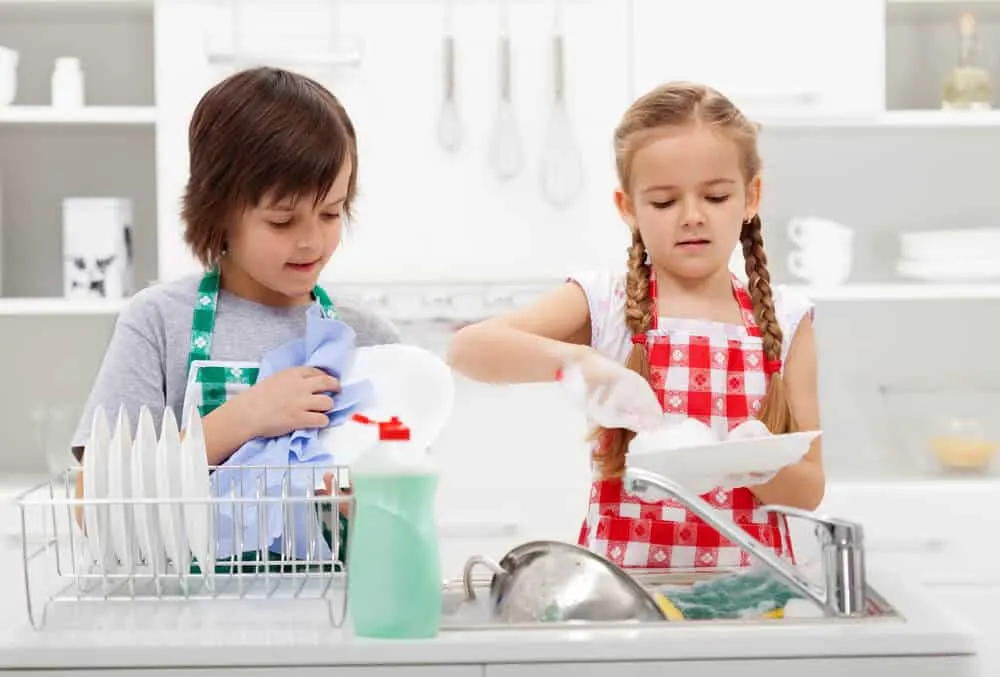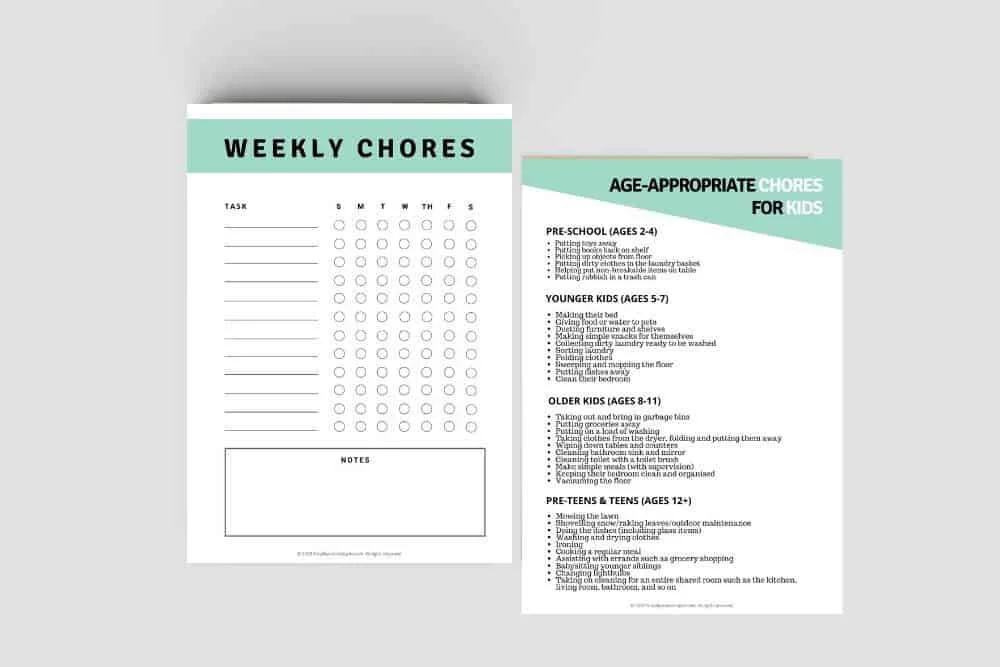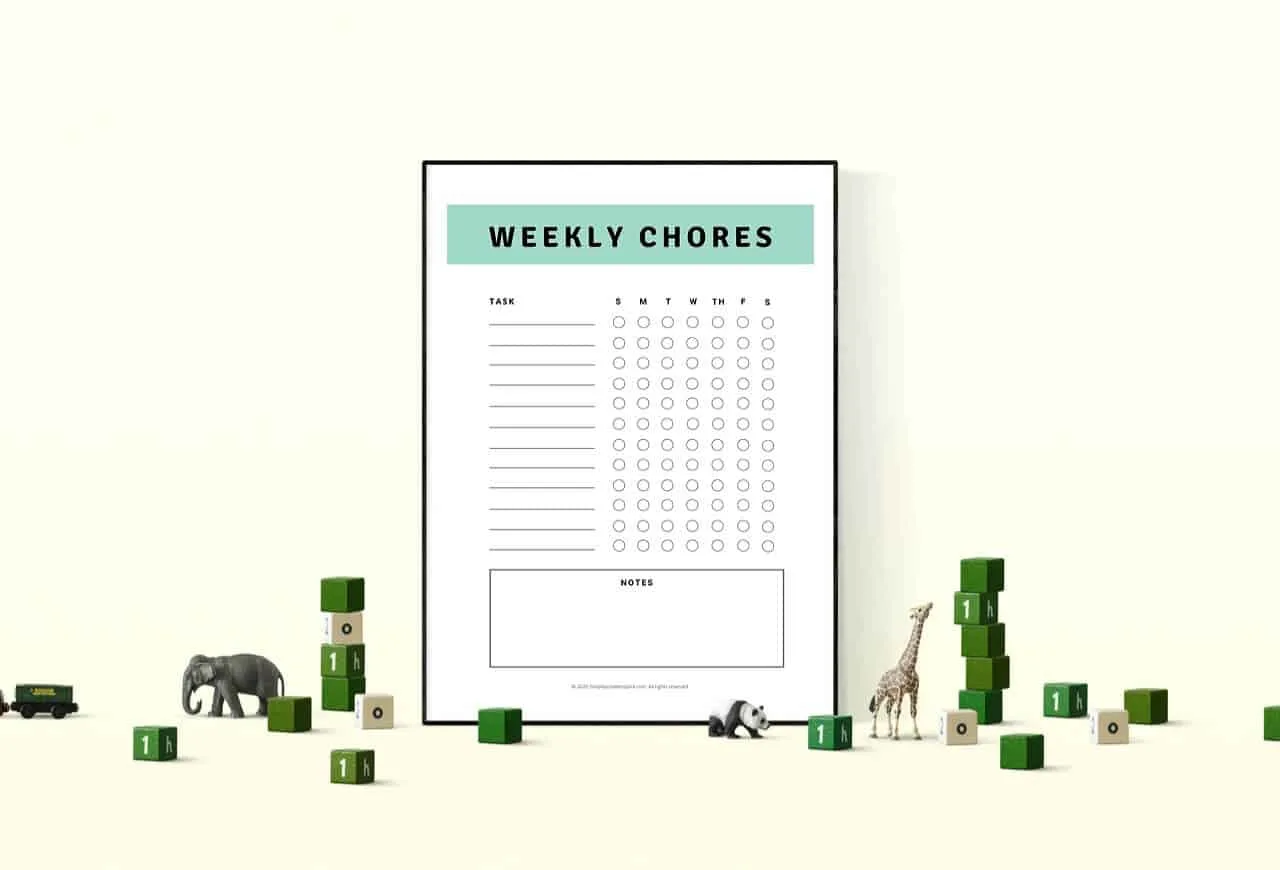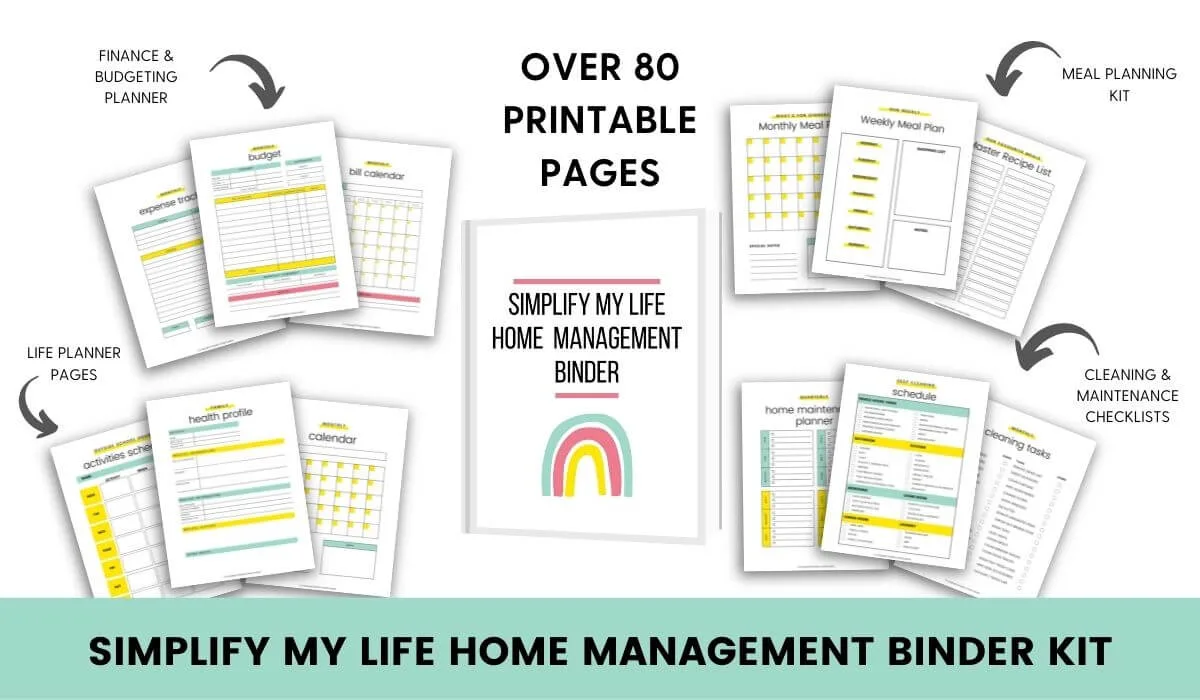Growing up with chores helps children become more responsible. and teaches them how to function in a household where everyone is expected to contribute. The type of chores you should assign your child will vary depending on their age. The following is a guide to age appropriate chores for kids divided by age group.

SEE ALSO:
- SMART goal setting for kids with printable worksheet
- Toy organisation ideas
- How to deep clean your entire house
- 7 ways to reduce cleaning time at home
- How limiting screen time has made our kids happier
The Importance of Chores For Children
The American Academy of Child and Adolescent Psychiatry has found that children who do have daily responsibility with chores may exhibit higher self-esteem, be more responsible, and be better equipped to deal with frustration, adversity, and delayed gratification compared to their peers who are not tasked with daily chores.
These developed skills can lead to your child having greater success in school, work, and relationships.
Without chores and household responsibilities, it is easy for kids to take for granted all the tasks that go into maintaining an organised home. And the later you attempt to introduce chores into their daily routine, the harder it may be.
Instead, they may grow up spoiled and expect everything to be done for them. This is the last thing anyone wants of their child.
It also means they will have limited life skills when the time comes for them to move out of the family home and start their independent life.
This is where setting chores for your kids can really benefit. Not only are you reducing your workload around the home, but you are also setting your children up for a successful future as a responsible teenager and adult.
Why Should Your Child Do Chores?
Kids benefit from helping around the home in many ways. Here are a few of the important skills and benefits it will assist them in developing:
- Teach them responsibility early on
- Help them to develop their independence and confidence
- Improve coordination and motor skills
- Decrease their sense of entitlement
- Encourage a helpful nature and collaborative mindset
- They develop a pitch-in mindset
- Set them up for the future when they are no longer in your household
- Give them an appreciation of how much you do to strengthen your bond
- Assist in developing resilience skills
- You lighten your own load with household tasks

How To Introduce Household Chores For Kids
The best way to introduce chores to your child is to start as soon as they are old enough to help. And you may be surprised at how early you can start!
While younger children who are not yet school age are limited in the types of tasks they can assist with, there are always simple tasks they can do. By starting this early, you are building an expectation of helping into their lives right from the start.
Even if it is something as simple as handing you their bowl after they finish a meal. This still sends a message to your toddler that there is more to be done once a meal is finished.
Introducing chores to older children may come with resistance. Especially if you have been doing everything yourself up until that time.
The best way to start is by having an open conversation with your child about the fact that they are getting older and it is their time to take a bigger role in the household.
This will help to frame chores in a positive manner with your child, even though we all know household jobs aren’t the most fun thing in the world!

Should My Child Receive Pocket Money For Chores?
Whether or not you want to make regular chores part of a pocket money system or not is up to you. While kids shouldn’t need extra motivation to help out around the house, the truth is that few children are motivated by this alone.
Pocket money can be a great incentive to keep them on track.
We use the Barefoot Investor for Families system of giving our children pocket money. In summary, Scott Pape’s system involves 3 weekly jobs that must be done to earn their pocket money.
The pocket money is split into 3 ‘buckets’ each week – spend, save and give.
This further reinforces responsibility and teaches early skills in managing money.
We set our kids 3 age-appropriate chores each that are their essential jobs to receive pocket money. There is also expectations for other daily jobs they are required to do outside of those 3. We manage this with a chore chart and our 3 bucket moneyboxes.
Here are some ways your kids can earn pocket money:
- Set a money value for each weekly chore – This allows your child to earn as little or as much as they want, depending on how many chores they complete in the timeframe. They may range from 20c to $1 each, with the value dependent on time and effort.
- Set specific tasks each week – Pocket money is earned once all set tasks are completed for the week.
Before You Start New Chores
It is essential your children know how to complete each of their chores before kicking off with a new one.
As they get older, the type and number of chores will increase and therefore you need to be ensuring they are confident with each one.
Take time to do new chores with your child for the first time. You may need to help them several times before they are capable of completing the chore solo.
Children will have better success at completing their assigned chores well and staying on track when they know what they are doing and have no lingering doubts.

Setting Age-Appropriate Chores For Kids
This guide to age-appropriate chores for kids will give you ideas on the type of chores your child can do, dependent on their age. However, these age recommendations are a guide only.
You know your child better than anyone and this means there are chores on this list that you may deem too difficult or too easy for their capabilities.
There are many other chore possibilities not listed that may be specific to your household or their lifestyle.
Chores For Ages 2 to 4
Younger kids and toddlers who are aged 2 to 3 can learn how to do simple, shared chores that teach them to take responsibility for their own messes and to help out others in the family. Kids’ chores at this age are mostly aimed at creating good habits early on.
Chores for children in this age bracket include:
- Putting toys in designated boxes/baskets
- Putting books back on the bookshelf
- Picking up objects from the floor (such as pillows, blankets, etc.)
- Putting dirty clothes in the laundry basket
- Helping put non-breakable items (such as silverware or plastic plates) on the table
- Putting rubbish in a trash can
Chores For Ages 5 to 7
Children who are aged 5 to 7 can start handling more complex chores, along with chores that go beyond simply picking items up such as tidying up their room. By this age, they should be taking on more responsibility as a helpful and capable member of the household.
Chores for children in this age bracket include:
- Making their own bed
- Giving food or water to pets
- Dusting furniture and shelves
- Making simple snacks for themselves
- Collect dirty laundry to be washed
- Sorting laundry
- Folding laundry
- Put toys away
- Sweeping and mopping the floor
- Putting dishes away
- Clean their bedroom by picking up and putting away toys and other objects
- Wipe baseboards
Chores For Ages 8 to 11
At this age, children should be doing chores that can involve greater responsibility along with more difficult tasks such as cleaning that requires scrubbing, wiping, and so on.
They can also begin sharing responsibility for cooking and helping in the kitchen. This helps raise self-sufficient adults by teaching life skills to kids from a younger age.
Chores for kids in this age bracket include:
- Taking garbage bins to the curb and bringing them back
- Putting groceries away
- Putting on a load of washing
- Taking clothes from the dryer, folding them and putting them away
- Wiping down tables and counters
- Cleaning bathroom sink and mirror
- Cleaning toilet with a toilet brush
- Make simple meals (with supervision)
- Keeping their bedroom clean and organised
- Vacuuming the floor
- Folding laundry
- Prepare simple meals (get them involved in meal prep to save you time with cooking)
- Clean animal cages
- Watering plants
- Clean bedroom
Chores For Ages 12 and up
Children who are aged 12 and older are ready to handle personal chores that are fairly similar to the ones they will need to handle when they are adults.
Children who are on the younger side of this bracket may still need supervision for some chores, such as anything involving lawnmowers or other equipment.
For teenagers, they are now at the age of being able to do many of the things you and the other adults in the home do.
Chores for children and teenagers in this age bracket include:
- Mow the lawn
- Shovelling snow/raking leaves/outdoor maintenance
- Doing the dishes (including glass items)
- Doing their own laundry
- Ironing
- Cooking a regular meal – incorporate it into your weekly meal planning
- Assisting with errands such as grocery shopping
- Babysitting younger siblings
- Changing lightbulbs
- Wash windows
- Take out garbage cans
- Taking on cleaning for an entire shared room such as the kitchen, living room, bathroom, and so on
Remember that children need guidance with chores. Make sure expectations regarding chores are clear so that your child knows what to do.
Consider setting up a chore list to remind them which chores are expected of them. In time, they will remember your expectations and be able to handle the chore without reminders.

Free Printable Chore Charts & Chore List By Age
To help you get organised with creating a regular chore schedule in your household, I have created a set of printables to get you started.
This 2-page set includes a printable chore chart that you can use with your child each week to track their chore progress. It also includes a list of age-appropriate chore ideas to help get you started.
Remember the chore list by age is aimed as a guide and that children’s skills vary greatly by age. Go with your instinct on what you feel they can handle at their age, but don’t be afraid to challenge them a little.
They will be continually growing and strengthening their skills, able to help with more difficult tasks around the home.
How To Use This Chore Chart
To cut down on paper waste, print one chore list per child and either laminate it or place it inside a plastic sleeve. Or place your chart in a photo frame with protective glass instead.
This way you can reuse the same chart each week by writing chores and keeping track using a whiteboard marker.
Fill in the weekly chores and tasks your child is required to complete in the task list and tick them off on the days they are done. Some chores may be daily, others may instead be weekly.
We keep our chart on the refrigerator for easy access, with a magnetic whiteboard market next to it.
GET YOUR FREE 2 PAGE CHORE PRINTABLE

Make sharing the household tasks an enjoyable experience for your child by encouraging, rather than nagging for chores to be done. Working together as a family encourages kids to pitch in and develop a team-player mindset. These age-appropriate chores for children will help make your home a more organised place overall!
Plus a tidy home is a happy home for everyone in the family!
Do I Need To Use A Chore Chart For My Kids?
As a parent, you may be wondering if you need to use a chore chart for your kids. The answer is that it depends on your family’s needs and preferences.
If you have younger children, a chore chart can be a helpful way to give them a sense of responsibility and ownership for helping out around the house.
You can use a chore list or image list to assign specific tasks to each child, and then help them to check off the tasks as they complete them. Often a visual representation helps younger children stay focused and on task.
It can also work as a behaviour rewards system if you feel this may benefit your child.
Older kids may not need a chore chart, but may still benefit from having some structure when it comes to chores.
You can talk with your kids about what kinds of tasks they would like to be responsible for, and then come up with a plan together.
Another option is to make a screen time chart where kids can earn screen time minutes by completing daily household chores independently. This can be a very effective strategy for reducing screen time and raising responsible and independent kids.
Whatever approach you take, it’s important to be consistent with your expectations and follow through with consequences if needed. With a little bit of planning, you can create a system that works for everyone in your family.
Still struggling to get the kids involved? Try out a cleaning game with your kids to see if they can resist having fun as they work through their chores. This is a great way to build good habits until they become more routine.
Get my Home Management Binder Printables

With over 80 pages of printables to help you manage your home and your life, this is the perfect way to create your home management binder – without having to make all the pages yourself!
This printable kit is undated so you can use the pages year after year and you can print them as often as you need them or skip a page if it isn’t relevant to you!
It includes all the family budgeting, meal planning, cleaning checklists, life planner, calendars, home maintenance and health pages to help you stay more organised at home!
Want more ideas to keep your home tidy? Check these out:
